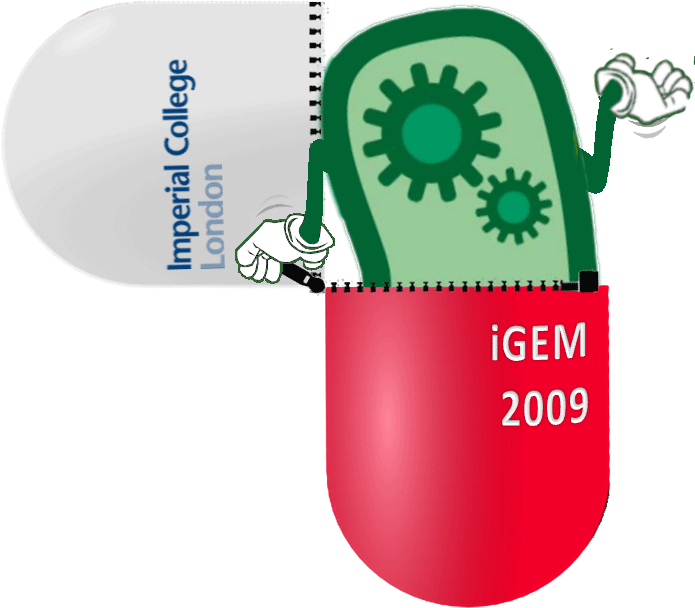Team:Imperial College London
From 2009.igem.org

For iGEM 2009 the Imperial College London team present you with The E.ncapsulator; a versatile manufacturing and delivery platform by which therapeutics can be reliably targeted to the intestine.

Our E.coli chassis progresses through a series of defined stages culminating in the production of a safe, inanimate pill. This sequential process involves drug production, protective encapsulation and genome deletion. The temporal transition between each of these stages is controlled by physical and chemical methods, showing a clear engineering approach to tackle this problem.
The E.ncapsulator provides an innovative method to deliver any biologically synthesisable compound and bypasses the need for expensive storage, packaging and purification processes. The E.ncapsulator is an attractive candidate for commercial pill development and demonstrates the massive manufacturing potential in Synthetic Biology.
- Growth
-
GrowthThe cells are grown to a critical cell density, before the system is started. It allows the culture to reach a sufficient cell number before the the cells are triggered to begin protein production. This is because protein production can slow cell growth.
- Module 1: Protein Production
-
Module 1: Protein ProductionThe first module is induced with IPTG, which triggers the production of the protein of interest. As part of this project we have looked into two proteins and a peptide of interest.
- Module 2: Encapsulation
-
Module 2: EncapsulationThe second module is where the cell, after having produced the peptide of interest, produces colanic acid. This creates a protecting layer around teh bacterium to shelter it from the acidity of the stomach.
- Module 3: Genome deletion
-
Module 3: Genome deletionModule 3 occurs after encapsulation of the cell containing the produced peptide of interest. This module makes the bacterium non-viable. It does so by over-expressing restriction enzymes which subsequently cleave the genomic DNA into small fragments. The cell is thus unable to produce any proteins and therefore unable to survive.
- Secondary Encapsulation
-
Secondary EncapsulationSeveral manufacturing considerations regarding the post-processing of the culture have been investigated. Post-processing of the culture allows the polypeptide filled cells to be converted into a pharmaceutical tablet, that can be taken orally.
- Chemoinduction
-
Module Integration: ChemoinductionModule 1 is induced by the addition of a compound, IPTG. This allows the user to 'kickstart' the system once the culture has reached a sufficiently high cell density.
- Autoinduction
-
Module Integration: AutoinductionModule 2 is triggered by a switch from glucose consumption to a secondary carbon source consumption. When the initial preferential carbon source (glucose) is exhausted, the system will metabolise the secondary carbon source that is available. This switch triggers the promoter that controls the start of Module 2. By knowing the initial concentrations of each carbon source, this acts as a programmable time delay system for the activation of encapsulation.
- Thermoinduction
-
Module Integration: ThermoinductionModule 3 is initiated upon an increase in temperature. The system is initially grown at 28°C, at which point Module 3 is repressed. When the temperature is raised to 42°C, this repression is blocked, triggering the start of Module 3. This temperature sensitive system was chosen as after encapsulation, chemical induction may be less effective due to limited diffusion.

 "
"





